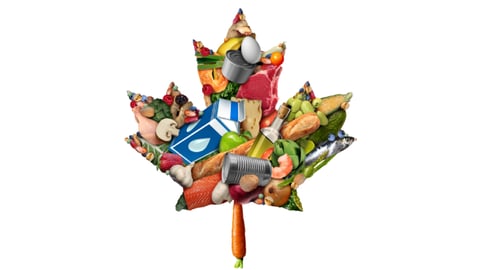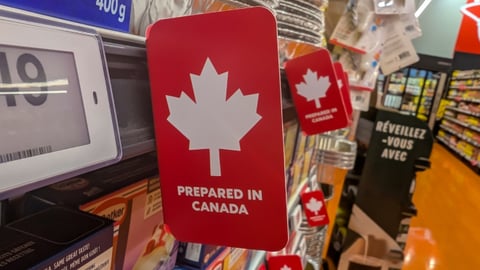The real rise of the ‘Buy Canadian’ consumer
With U.S. tariffs and political tensions still an ongoing concern, Canadian consumers are drawing a clear line—in the grocery aisle. New research from NIQ found that nearly half of Canadians are taking a stand—from boycotting U.S.-made goods to choosing Canadian products, even when they’re not the easiest or cheapest option.
In this Q&A, Mike Ljubicic, managing director at NIQ Canada, shares insights from NIQ’s latest studies—Trade tensions and the rise of the Buy Canadian consumer and Made in Canada: How are Canadians responding to U.S. tariffs?
He discusses how both U.S. and Canadian brands are impacted, what strategies they can adopt, and why this isn’t just a passing moment for the maple leaf.
How would you characterize the size and scope of shifting consumer behaviours amid ongoing trade tensions?
There are two things: how people say they’re going to react and how they actually react. We heard Canadians say they’re going to avoid or boycott U.S. products, and some said they would, depending on the price. At NIQ, we’ve developed a new solution that codes products such as Product of Canada, Made in Canada, Made in the United States and Origin of Canada. Looking at the last 12 weeks, Product of Canada, which means that 98% of the product costs happen in Canada—that’s materials, labour, ingredients, processing—are up 5% in dollars and about 1.2% in volume. When we look at products that are Made in Canada—that is, 51% processed in Canada—they’re down about 2% in dollars and just under 5% in volume.
What’s interesting, though, is stated Made in the U.S. products are down 8% in dollars and about 8.5% in volume. So, that tells me that what people are saying they’re going to do is impacting how they’re behaving in the stores. We are seeing people in the stores checking products and reading labels a bit more. Now, is it as high as I thought it was going to be? Maybe not, but it still is a sizable chunk for sure in terms of volume and dollars.
READ: Canadians still sticking it to America at the grocery store, report finds
How does this shift compare to past major shifts in the grocery and CPG industry?
When you look at past shifts, typically during tougher economic times, people shift more toward discount banners—the No Frills, the Food Basics, the FreshCos—and you’ll see them lean towards promotions and private label. Then, when things improve, they revert a bit.
One thing that’s happened in Canada since Covid, though, is discount continues to grow and promotions continue to thrive. Today, 50% of all the volume sold in Canada is sold on promotion. That’s double what it is in the United States, and in many categories, it’s even as high as 60%. In fact, when I looked at stated Made in the U.S. products, 60% of that volume was on promotion.
I don’t think those trends are going to revert anytime soon, simply because people have less money in their wallet today. They’ve become more frugal with their spending, they’re focused on the essentials and they’re trying to save wherever they can.
In 2008, discount represented one third of the volume in Canada and conventional was two thirds. Today they’re 50/50. I think discount is going to tip the scale and it will continue to grow. The offerings are there, the prices are a bit better and retailers are investing in discount because that’s where consumers are going. Value is growing in a lot of segments. So, I think those trends are going to continue, and tariffs are another phenomenon that’s just going to continue to snowball these shifts moving forward.
Your research identified four new customer segments: “pragmatic Canadian supporters” (51%) who prefer Canadian products but will still buy U.S. if necessary; “American goods avoiders” who boycott U.S. products in favour of Canadian or non-U.S. options (32%); “Canadian loyalists” who only buy Canadian and go without if a Canadian option is not available (13%); and 4% remain unchanged. Given these segments, what are the key risks and opportunities for both American and Canadian CPG brands?
From a Canadian perspective, the question is: how do you become more self-sustainable? How do you continue to grow? Quebec is a perfect example. It’s a province where local has always been stronger than anywhere else in the country—27% of all brands sold in Quebec are Quebec-based. Therefore, I wasn’t surprised in our surveys that they were the most vocal about buying non-American products.
That shift will continue to create opportunities to offer more products from Canadian companies, but that can also include American companies that are producing and manufacturing in Canada. Kraft has done a really good job communicating that. Their commercials talk about being made in Canada—their plants are here and they’re employing Canadians. I think they’ll have to continue to market that message.
Most of the large FMCG companies that operate here in Canada—Pepsi, Coke, Kraft, Hershey, Conagra, Mondelēz—still produce a lot of their products in Canada. There is some importing for sure, but a lot of their products are still made here. And so, how do you continue to communicate that message so that people are aware? I think that will resonate with a lot of people. On the flip side, there will still be those who look for Product of Canada because they’re 98% produced in this country.
But, for the vast majority, wallets are tight and people are still restricted by tougher economic times. If you can get close enough and provide a good offering for a good price, people will take into consideration that it’s made in this country and it’s employing Canadians.
Given that 55% of Canadians find it easy to identify “Made in Canada” products, while 45% do not, what can retailers and CPG brands do to make it easier for consumers to identify Canadian-made goods?
Generally, retailers have done a pretty good job of flagging Made in Canada products. There are certain departments where it may be tougher to identify, for example, deli and bakery areas. So, those are opportunity areas. In a bakery department, if I’m buying a loaf of bread that’s UPC-coded, it’s easy—I can flip the pack and see where it’s made. But if I’m buying loose buns that are PLU-coded, there’s no indication of which country they’re from. You might assume the flour is from Canada, but you can’t really identify the country of origin.
READ: Why made in Canada brands need to go beyond the label
It’s been suggested that retailers should have a Canadian section in the store versus a non-Canadian section. That’s logistically tougher to do because of the cost of re-planogramming, and changing everything isn’t easy. But for the most part, Canadian stores have done a good job.
Another consideration is online. It’s very important to make sure that even on your e-commerce sites, Canadian products are flagged properly, so when people are clicking and buying, they can easily identify them.
Where do you see the ‘Buy Canadian’ movement headed?
I think there’s going to be a certain element that will stick over time, just as it has in Quebec. As I mentioned earlier, Quebec has done a really good job over the last 10 or 15 years elevating the presence of their local brands. We’re starting to see other provinces—especially in the Prairies and the Maritimes—follow suit.
People are taking things into their own hands, trying to become more self-sustainable and helping local companies grow. At the same time, larger companies are looking at how they capitalize on this shift and produce more in this country to meet future demand. So, some of this is not going away. It’s just going to layer on to trends that have been building over the last number of years.



